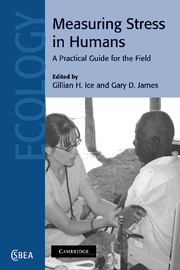Foreword by Geoffrey A. Harrison
Published online by Cambridge University Press: 11 September 2009
Summary
Stress has been recognized as an important psycho-physiological state since the pioneering work of Hans Selye. But until quite recently it has mainly been perceived in humans as a condition generated by extreme and hostile environments such as going into battle, hospital or academic examinations. Increasingly, however, it has been identified as being a consequence of many aspects of lifestyle and the events of everyday living and that, to varying degrees, large numbers of people experience it. Indeed, from the point of view of long-term health, low-level frequent chronic stress is likely to be much more important than occasional acute episodes.
Chronic stress can hardly be studied by experimental procedures in the laboratory. It clearly needs a population approach with investigators monitoring people in the “field” as they go about their daily business. Psychologists have gained important insights by the design of questionnaires which can be applied not only to particular groups undertaking activities which are deemed to be stressful, such as air traffic controllers, but also to whole populations, experiencing a diversity of lifestyles. They have identified various elements, particularly in occupational situations, which aggravate stress, as for example absence of job control, but questionnaires are of little use outside one's own language, or at least culture. They also have questionable validity in the study of children.
For these wider studies it is necessary, or at least desirable, to have some physiological measures of the stressed state, either of the homeostatic mechanisms which are elicited to control stress or of the morbid consequences of being stressed.
- Type
- Chapter
- Information
- Measuring Stress in HumansA Practical Guide for the Field, pp. xi - xiiPublisher: Cambridge University PressPrint publication year: 2006



